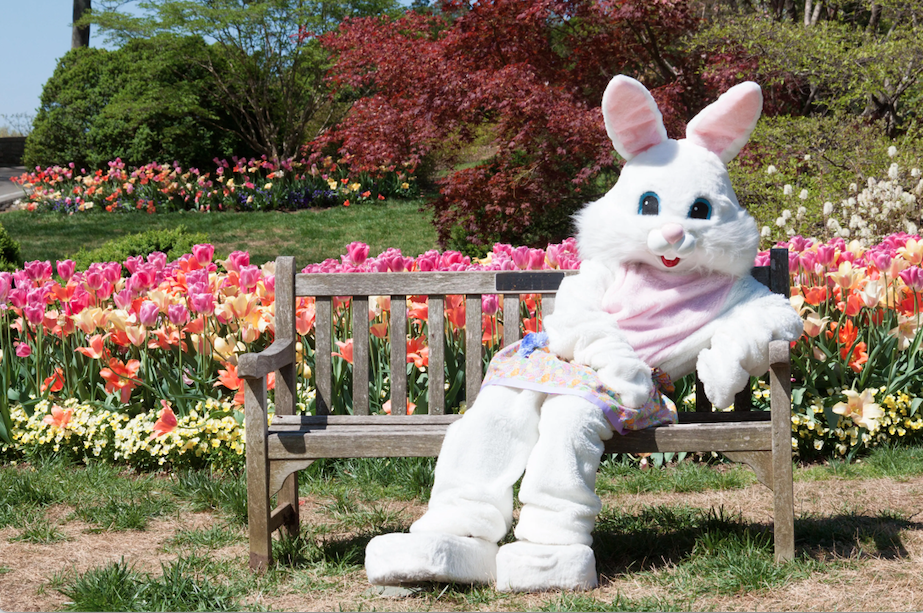
Meeting the Easter Bunny: Scarier than Santa Claus?
Back in December, we published an article debating whether taking your children to meet Santa Claus was a lovely family tradition or simply traumatizing. Personally, growing up I was never afraid to meet Santa Claus. I even texted my mom to confirm! She also said I was never afraid to meet the Easter Bunny either… but I’m not too sure about that.
Growing up, Easter photos at the mall were not as big a deal as pictures with Santa, so that wasn’t really a huge part of my childhood. However, now that I’m an adult, I just want to take this time to recognize that the Easter Bunny is pretty creepy. I have to be cautious of anyone who thinks a jolly, round human in a red suit is more terrifying than a giant bunny with human-like eyes that continuously stare into your soul. I mean, at least Santa blinks.
Don’t get me wrong, I love Easter. I love any excuse to get all dressed up in pastels and enjoy a family barbecue or crawfish boil on a beautiful, bright, Louisiana Sunday. As a child, I loved hunting for eggs and waking up in the morning to see what the Easter Bunny brought me, and as an adult, I love going to church, hiding eggs, and helping the littles with their hunts. But now, I can’t help but wonder who thought it was a good idea to start this yearly tradition of sitting on a giant bunny’s lap.
The Origin of the Easter Bunny
Like Christmas, Easter is a Christian holiday that each family celebrates in their own way, depending on their different religious and cultural backgrounds. No matter what you and your family do on Palm Sunday or the days leading up to it, there’s one common symbol everyone can recognize: the Easter Bunny.
Before Christianity, a pagan festival around the March equinox celebrated the fertility goddess Eastre, featuring symbols like hares and eggs to represent renewal. Some scholars propose that Christian missionaries in Medieval Europe aligned Easter with these pagan customs to convert Anglo-Saxons, leading to the association between rabbits and the Christian holiday.
The tradition of the egg-laying rabbit, called “Osterhase” or “Oschter Haws,” was brought to Pennsylvania by German Lutheran immigrants in the 1700s. Initially, German children made nests for this rabbit to lay colored eggs, and this custom later spread throughout the United States. Over the years, the Easter Bunny’s role expanded to include leaving candy and gifts for children.
When Did the Bunny Reach Celeb Status?
Now that we’ve established the origins of the Easter Bunny itself, we need to get to the bottom of why we started having photoshoots with it. Again, I’ve always loved dressing up for Easter, but dawning your best church clothes just to go to your local mall, stand in line for an hour, and then sit on the lap of a furry for five minutes while cries of terror from the next kids in line fill the air? Yeah, I’m good.
My research found that companies and household brands started using the Easter Bunny as a marketing symbol (like on postcards, stamps, etc… not like modern-day marketing campaigns) dating back to the 1800s, but it wasn’t until the 1950s that the bunny started becoming more… human-like. It was around this time that Easter Bunny photoshoots really started taking off and traumatizing children for years to come.
I’m sure for many children, meeting the Easter Bunny is a joyous, fun-filled experience. After all, how exciting does it sound to finally meet the mega rabbit that sneaks into your house one night a year to leave a basket full of candy and colorful eggs all over your yard? You know, those tiny, chocolate-filled plastic eggs or real straight-from-the-chicken, dyed eggs that you’ll only find about 90% of and your dad will find the rest of them a week later the next time he mows the lawn? Yes, truly exhilarating.
Where Do We Draw the Line?
A big point discussed in the article about taking your children to meet Santa was that children should only do it if they want to. Parents shouldn’t subdue their kids to this emotional trauma if they cannot verbally consent to it. Fair point, right? If we want our children to learn the difference between “yes” and “no,” then we need to be the example in every scenario.
I’m not saying that we should necessarily “cancel” the Easter Bunny (although that wouldn’t be the most shocking thing to come out of 2024) but maybe it’s time to step back and see how we can set boundaries in these situations. As Ashley Wehlri said in Sitting in Santa’s Lap: Tradition or Traumatizing, “When we think about parenting, we think about all the values we try to instill in our children. We shape them as they grow, and there are certain things we need them to know, both for their safety and their moral compass, as they age.”
Take these words into consideration this March as you begin planning your children’s annual Easter photoshoots. No matter where you stand on the matter, as long as you are respectful of your children’s decisions and remember the true meaning of the Easter holiday, you should enjoy this time with your family and friends however you’d like.
With all of that being said, please don’t get me started on St. Patrick’s Day leprechaun traditions… I’m still traumatized (and incredibly furious) with that little guy from when he completely trashed my pre-k classroom back in 2005. Some things you just can’t let go.

